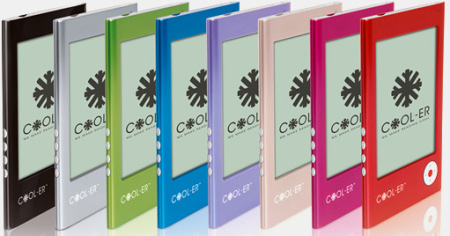Light, low-cost e-reader runs Linux
May 29, 2009 — by Eric Brown — from the LinuxDevices Archive — 5 views A U.K. startup called Interead will soon ship a Linux-based e-book reader claimed to be about 40 percent lighter than an Amazon Kindle 2, and over $100 cheaper. The “Cool-er” is equipped with a 400MHz ARM9 Samsung processor and a six-inch E-Ink Vizplex display.
A U.K. startup called Interead will soon ship a Linux-based e-book reader claimed to be about 40 percent lighter than an Amazon Kindle 2, and over $100 cheaper. The “Cool-er” is equipped with a 400MHz ARM9 Samsung processor and a six-inch E-Ink Vizplex display.
(Click for larger view of the Cool-er)
The Cool-er manages to slip out the door for $260, instead of $360 for the Kindle 2, due in part to its lack of wireless connectivity. Not only is there no cellular modem, as in the Kindle, but no WiFi, as found in some other e-book readers, so to add new books, users will need to hook up to their Windows or Mac computers via USB. Although like the Kindle and most other e-book readers, the Cool-er is based on embedded Linux, Linux desktops do not appear to be supported for USB connectivity.

Cool-er color options
The Cool-er may lack the Kindle's always-on 3G cellular modem, but the Kindle only works on Sprint's U.S. network, and Interead appears to be aiming for a more global audience. The device's simplicity also means a lower cost and a slim, 7.2 x 4.6 x 0.4-inch form factor. More striking is its 6.3-ounce weight, which is about 40 percent less than the 10-ounce, 8 x 5.3 x 0.36-inch Kindle 2 and a third the weight of the new super-sized, 10.4 x 7.2 x 0.4-inch Kindle DX. The Cool-er's 1000mAh Li-Ion battery is said to deliver up to 8,000 page turns per charge.
 Kindle 2 |
The Cool-er is equipped with a 400MHz, ARM9-based Samsung S3C2440 system-on-chip (SoC). Launched in 2003, the widely used S3C2440 primarily targets handheld devices such as smartphones and PDAs. By comparison, the Kindle 2 (pictured at right) moved up to a more powerful ARM11-based Freescale i.MX31 SoC clocked to 532MHz.
The Samsung SoC is backed up with 128MB RAM and 1GB flash. Unlike the new Kindle 2 and Kindle DX, the Cool-er offers a welcome SD card slot that can store up to 4GB, although the Kindle 2 now offers 4GB flash as standard.
For the display, Interead turned to the ubiquitous E Ink Vizplex technology, which has (finally) made the e-book more than a footnote in consumer electronics history. While it offers the same six-inch dimensions of the Kindle 2, it lacks that new model's 16-grayscale version of the E Ink technology, getting by with the standard eight grayscales. Following the Technicolor Ugly Betty trend in consumer electronics, the stylish Cool-er is offered in eight vivid colors.
Interead boasts that its CoolerBooks.com download site offers 750,000 e-books. The Cool-er is also said to support a variety of formats, including JPEG, PDF, TXT, and Adobe's DRM/EPUB. The latter is said to open the door to a wider variety of publications than are offered by the Kindle.

Cool-er colors
Specifications listed for the Cool-er include:
- Processor — Samsung S3C2440 400MHz
- Memory — 128MB
- Flash — 1GB
- Flash expansion — SD reader for up to 4GB
- Display — 6-inch E Ink Vizplex with 8 grayscales, 170 pixels per inch
- USB — 1 x USB port
- File formats — JPEG, PDF, EPUB, TXT, RTF, MP3, PDF, DRM/EPUB
- Other features:
- MP3 player
- 8 language options
- 750,000 book titles
- 8 color options
- Landscape/portrait options
- 8 text sizes
- Battery — Li-Polymer battery (1000mAh); 8,000 pages claimed per charge
- Dimensions — 7.2 x 4.6 x 0.4 inches (183 x 118 x 11mm)
- Weight — 6.3 oz (178g)
- Operating system — Embedded Linux; supports connections to Windows and Mac desktops



Hanlin eReader, Bookeen Cybook and Foxit eSlick (from left to right)
(Click any for details)
Like the Cool-er and the Kindle, most new e-book readers seem to run embedded Linux. These include the devices pictured above: the Hanlin eReader V3, the Bookeen Cybook, and the Foxit eSlick.
Availability
The Cool-er is due to ship in early June for $250. More information may be found here.
This article was originally published on LinuxDevices.com and has been donated to the open source community by QuinStreet Inc. Please visit LinuxToday.com for up-to-date news and articles about Linux and open source.